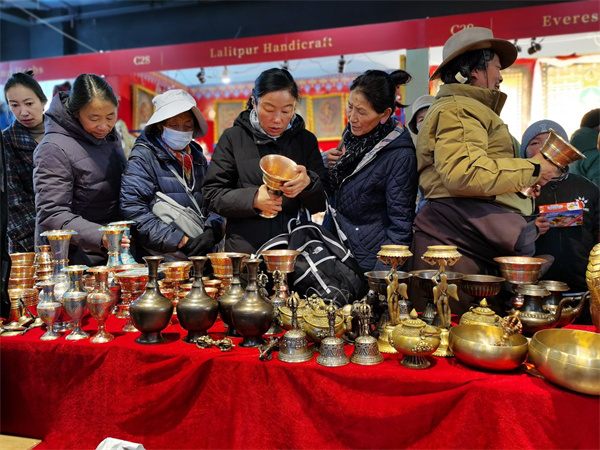Import fair kicks off in Lhasa prior to Losar celebrations
Updated: 2024-01-15 By Palden Nyima and Daqiong in Lhasa (China Daily)  Print
Print 



With the participation of merchants from Nepal and Bhutan, an exhibition fair featuring exported products kicks off in Lhasa, capital of the Xizang autonomous region, on Thursday, to welcome in the New Year. [Photo by Palden Nyima/For chinadaily.com.cn]
The streets of Lhasa, capital of the Xizang autonomous region, are alive with a festive atmosphere as locals have been preparing to celebrate the upcoming Tibetan New Year, also known as Losar.
Inside the bustling first floor of Gakyiling Plaza Shopping Mall, merchants sell various products, such as bronze sculptures, carpets, rugs, clothing, handicrafts, wooden containers, rice and a wide selection of nuts.
It's all part of the 11-day exhibition fair of imported products for locals shopping for New Year needs, with the shopping extravaganza to last till Jan 21.
Lhamo, a resident of Lhasa, was delighted to see such a wide selection of imported goods, saying, "I absolutely adore the handicrafts from Nepal and Bhutan. The festival offers a vast range of imported goods that are not only diverse, but also reasonably priced."
Tibetan New Year in Lhasa matches this year's Spring Festival, landing on Feb 10. But not all Losar celebrations fall on the same day, which vary depending on altitude and harvest time. Residents throughout Shigatse and a few other places began celebrating Sonam Losar, or Farming Losar, on Friday. But it's common for celebrations to begin weeks earlier.
Sonam Jampel, general manager of Xizang Kakila Trading Company Ltd, which hosted the fair, said that the time is a peak season for sales of imports."Tibetan consumers have a special interest in Nepalese carpets and ornaments, as well as imported food items like nuts."
According to the city's commerce bureau, this event has attracted over 70 companies, mainly from Nepal and Bhutan.
Zhao Hancai, an official at the bureau, said that over 1,000 people attended the fair on Thursday, with transactions amounting to 800,000 yuan ($111,000), and the fair is expected to generate 16 million yuan in revenue for Lhasa.
"We encourage enterprises to hold more such events, providing locals with international, high-quality, and theme-based consumption experiences, to enhance local consumption and better meet the demand for South Asian imported goods," said Zhao.
Xizang has played a pivotal role as a vital hub on the ancient Southern Silk Road, and the Ancient Teahorse Road in days long gone. It has also served as an international passageway connecting ancient China to South Asia.
Xizang has seen robust growth in trade in recent years. In the first 11 months, it has conducted trade with 173 countries and regions. Nepal remains the predominant trading partner, with bilateral trade valued at over 25 billion yuan, representing a year-on-year increase of 72.7 percent, said Lhasa Customs.
"Imported products have become a significant choice for Lhasa residents as their living standards improve in recent years. In 2023, we hosted two import product exhibitions in Lhasa," Sonam Jampel said.
Jigme Tenpai Gyeltsen, a young exhibitor from Bhutan, expressed confidence in the success of the fair. His family's collection primarily comprises wooden bowls, wooden boxes and traditional clothing.
"The organizers have coordinated and arranged our accommodations, catering and transportation to our utmost satisfaction. Today, we are gradually preparing to exhibit our products," said Jigme Tenpai Gyeltsen, adding it's the second time that they participated in the import expo.
palden_nyima@chinadaily.com.cn








